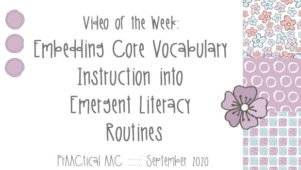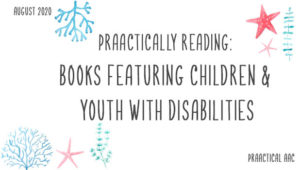PrAACtically Reading: Over on the Farm with Karen Natoci & Karen Baca
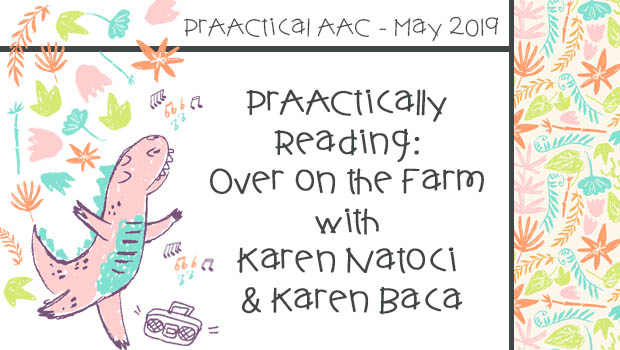

 Are you ready for some reading, AAC style? In today’s edition of PrAACtically Reading, Karen Natoci and Karen Baca share a preschool book about farm animals. Karen Natoci is an AAC Supervisor who is well-known to the readers of this site (see her wonderful contributions here.). Her colleague Karen Baca is an AT and AAC Specialist with over 30 years in the field of AT, specializing in AAC, alternative access, and literacy for all students with disabilities. They both work for The Speech Pathology Group in the San Francisco Bay area.
Are you ready for some reading, AAC style? In today’s edition of PrAACtically Reading, Karen Natoci and Karen Baca share a preschool book about farm animals. Karen Natoci is an AAC Supervisor who is well-known to the readers of this site (see her wonderful contributions here.). Her colleague Karen Baca is an AT and AAC Specialist with over 30 years in the field of AT, specializing in AAC, alternative access, and literacy for all students with disabilities. They both work for The Speech Pathology Group in the San Francisco Bay area.
Book: Over on the Farm by Marianne Berkes and illustrated by Cathy Morrison (Copyright © 2003, Little, Brown and Company; Hachette Book Group, www.lb-kids.com)
Vocabulary focus: All core words
Fringe Vocabulary focus: horse/foals/neigh, cat/kittens/meow, cow/calves/moo, goat/kids/maa, chicken/chick/cheep-cheep, owl/owlets/hoot-hoot, mouse/pups/squeek, turkey/poults/gobble-gobble, duck/ducklings/quack, pig/piglets/oink
Actions: peck, nibble, swish, wash, gallop, hide, fly, strut, waddle roll
Communication Matrix (Rowland, 2009) level: I-VIII
Connection to personal, familiar knowledge: pets
It’s spring! Baby animals are everywhere! Our classroom scheduled a trip to the local farm so we decided to talk about animals for two weeks beforehand. We selected the book Over on the Farm which offers dense illustrations, lots of rhyming words, simple math concepts and the potential for much interaction for every learner in the classroom. Animal talk is fun! As an introduction to the experience of animals, ask if your students have any pets or if they have ever been to the farm and consider reaching out to families to see if they might send a photo of their pet or farm experience to you. Once you receive this, it would be good to add this language programmed as “news” in their AAC Systems or printed in a low tech photo/topic book for later reference.
Over on the Farm can promote lots of fun conversation. When reviewing this book, we do see a lot of specific fringe vocabulary and it is always optional whether or not to add these words to the student’s AAC system.
The following ideas are derived from the work of Drs. Karen Erickson and David Koppenhaver. Please review this paper authored by Dr. Erickson and published in the American Journal of Speech-Language Pathology (Vol 26, 193-205, May 2017: Comprehensive Emergent Literacy Instruction: Clinical Forum: Interprofessional Collaborative Practices in Service Delivery for Individuals with Severe Disabilities.
The following describes how we implemented a comprehensive literacy program in a small kindergarten classroom of students, some with complex communication needs. The ideas here can work with students of all ages who use AAC, although a different book may be chosen or composed.
Shared Reading happens when a story is orally read to the class. The readers should exhibit the shared joy of it all, pause and allow for interaction from the students (multi-modal). We paused in between page turns. The pausing & waiting allowed child led interactions to occur (some of our students used AAC systems to comment, say a repeated line, or express themselves while we interpreted their interactions positively, attributing meaning to all of their attempts.) Students using AAC systems will have something to say with the core word page at hand. Another option is to go to the animals page. Note that insisting that students label animals correctly in any way will distract from the purpose of this shared reading experience. In this photo, Ms. Natoci is singing the story while holding a toy pig. Ms. Baca is co-teaching by modeling the key word, pig.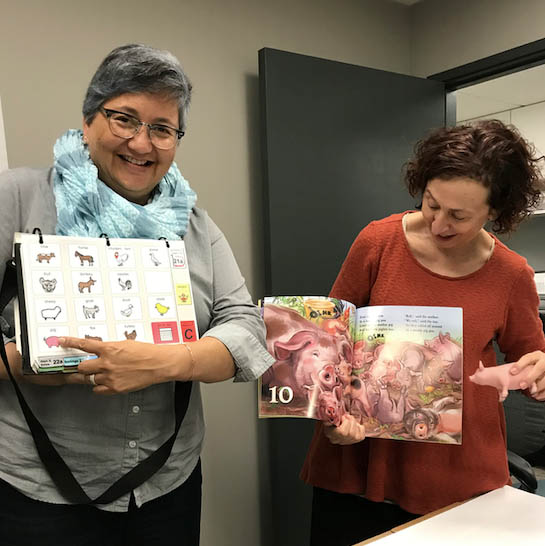
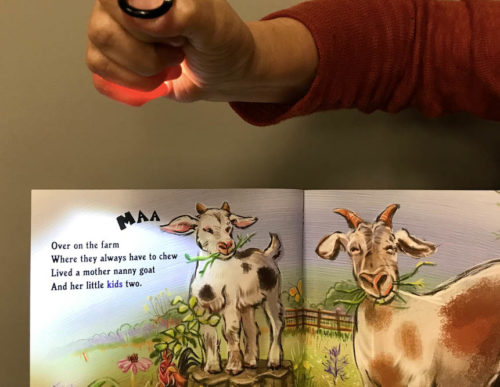
The purpose of Shared Reading is to foster engagement in the book reading process, draw attention to the text and learn what books are. It can be done often and with some variety by:
- Reading or Singing the book.
- Inserting pauses in between pages (appropriate wait time)
- Observing the students for changes in behavior, listen
- Listening for comments, indicating interest
Students must have access to their AAC systems just in case they have something to say (single message system, low, mid or high tech devices to label, comment express core words, intentionally or not.) This way, the reader may respond to their comments or behavioral communication in a way that attributes meaning, drawing them into the story. Use wait time and it is best not to provide operational prompts such as, “hit the switch” or, “say this.”
We find that most students appreciate augmenting the book with objects, remnants from the field for a multi-sensory experience.
You can read the same book (a bit differently) every day:
- Sing the book
- Emphasize the text
- Model key word per page
- Reference a core word (i.e., ON) seen on a large core board or by the instructional assistant using the child’s system.
- For one of our students using objects, he chose his favorite animal using this array of two. He was a new student and we were getting to know him but wanted him to be included in this activity.
The Shared Writing process is delivered through predictable chart writing. In the paper referenced, Dr. Erickson shares a 5 step method beginning with the large writing activity produced as a whole class. Here’s how we did it:
Here’s how we did it:
Step 1: We created a very simple, two-word sentence while engaging as a class in the shared writing process using poster sized post-it paper. Each student named an animal and used a core word to fill in the blank. We wrote their names and noted what AAC system they used.
Step 2: We practiced reading the chart out loud. If you are studying a letter of the week, you can circle those letters if you’d like. We didn’t do that because we wanted the print to stay pretty clean. This is the point where specific elements in the sentences would be pointed out (such as letters, same words, patterns.)
Step 3: The sentences were cut into strips, then the students were asked to help us cut the strips into words. Two of our students couldn’t point so we used a bright red pair of scissors (positioned to cut) and slowly scanned across the strip (partner assisted) so that the student could say “when” to cut in between the words. It is good to allow for mistakes (many students will say “cut” or point right to the middle of the word. In that case, we would go ahead and cut the word and then look at it together, re-tape it and try again, pointing out where the word ends (teach where to see the spaces in between words.) Next, students helped reassemble the words to make the sentence and this was glued onto construction paper. Students directed us by telling us where each word goes. Please see the photo of page, “Chicken eat” on the yellow construction paper. Students also drew their own pictures with the support of their instructional assistant. We drew a speech bubble to be filled in during their writing activity later.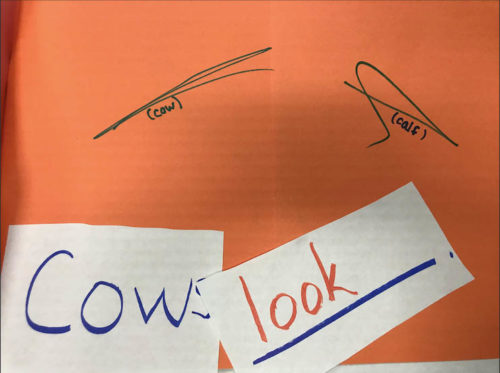
Step 4: It was time to play the game: “Be the Sentence.” One of our students decided that this game should be called, “sentence people.” We played this game on a different day later in the week. We ended up reprinting each word on large unlined cards. Students choose people to “be their sentence.” In our case, the sentences were only two words so they chose a partner to be a “sentence person” with them. The “sentence people” went to the front of the class and they lined up to form the sentence. The sentence people held the word and spoke it separately. In one example, Ms. Baca said, “Owl” and the Sierra used her Accent 1000 to say “think,” (reading her word). This was done to help students gain a sense that each word is separate and together, becomes a sentence. This was a lot of fun. Errors were okay, too. When playing “sentence people”, it is important to make sure that everyone has a means to say the word that they are holding.
Step 5: We resumed creating pages of what will be our class book. Students drew a picture of their animal (using their preferred drawing means). We added the speech bubble for their writing task (to be done later during the school day, see below.)
Finally, we put it all of the pages together to make a class book. We titled our book: What do Animals Do?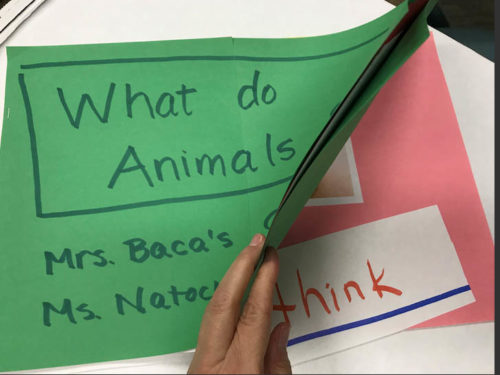
Independent writing practice is done with students having access to the whole alphabet. We added a word bubble to their drawings so that our students may compose what their animal is saying. Students used their alternative pencils to write what the animals said and we supported this verbatim. In this photo, Carlos used his TouchChat (alternative pencil) to write CBEB. His teacher presumed that this meant “cheep-cheep” and you can see that Mrs. Baca modeled the word under his work, using the alphabet found in his TouchChat page.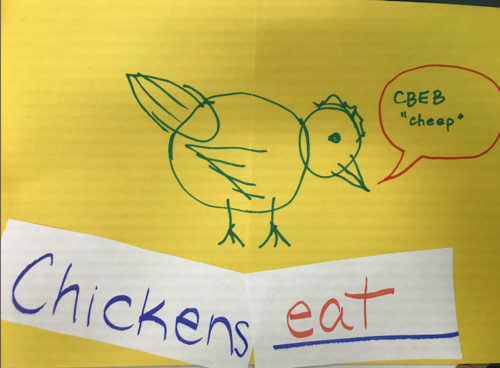
Alphabet practice is another important area of emergent literacy instruction and this turned into great fun! We engaged in word sorts looking at the first letter of animal names. By now, the conversation moved beyond the scope of the book and included a variety of animals. We printed a list of animals that started with two different letters: D: dog, duck, donkey, deer, and C: cow, cat, camel, cardinal. Here, we read the printed words and focused on the initial sounds. Students took sorting words based on the first letter sound. One student decided to engage by using his duck toy.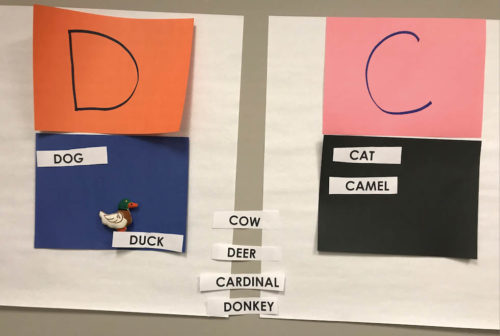
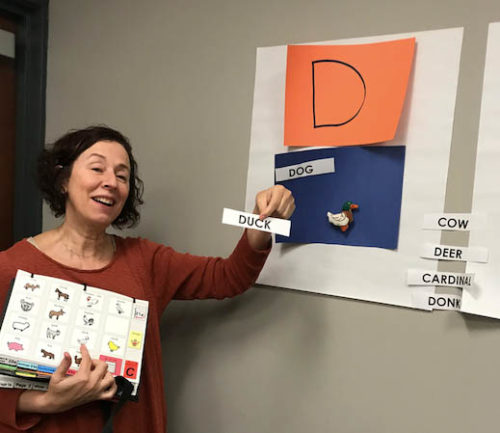
The bottom line, love the story, love the print! Emphasize the print, the alphabet, and the amazing sounds that letters make! Have fun. It is even more important for AAC users to build their foundation with literacy so that they may be able to communicate orthographically. This can be done through comprehensive emergent literacy intervention described in Dr. Erickson’s paper. Thoughtful literacy instruction allows AAC users to own their language, not choose their language. Please let us know if you adopt this lesson and how it goes in your setting. We’d love to hear!
Filed under: Featured Posts, PrAACtical Thinking
Tagged With: Books, emergent literacy, preschool, reading
This post was written by Carole Zangari

